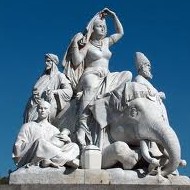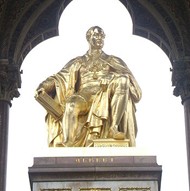John Henry Foley
Biography of Victorian Sculptor
From Dublin, Ireland.
![]()
![]()
|
John Henry Foley |
 The "Asia" sculpture from the Albert Memorial, Hyde Park, London. |
John Henry Foley (1818-1874)The first major figure in Irish
sculpture, John Henry Foley was born in Montgomery Street, Dublin
in 1818. He is best known for his heroic and monumental statues, including
that of Daniel O'Connell ('The Liberator') on O'Connell Street, Oliver
Goldsmith and Edmund Burke on the grounds of Trinity College, Dublin and
Henry Grattan on College Green, Dublin. |
 The Memorial statue of Albert (1875) Albert Memorial, Hyde Park, London. By John Henry Foley & Thomas Brock. |
|
MORE ABOUT SCULPTURE |
At the age of 17 he moved to London to
continue his studies at the Royal Academy, where he was later to become
an associate member in 1849 and a full member in 1858. His first public
success came in 1840 when he exhibited his Death of Abel and Innocence
and 'Ino and the Infant Bacchus', which resulted in a commission from
the Earl of Ellesmere, who wanted a version executed in marble for his
collection at Bridgewater House. This success was quickly followed by
others, including Lear and Cordelia and Death of Lear , exhibited in 1841;
Venus Rescuing Aeneas and The Houseless Wanderer , exhibited in 1842 and
Prospero and Miranda in 1843. |
|
HISTORY OF SCULPTURE WORLD'S
BEST SCULPTORS |
Although a master in both stone and bronze, Foley's sculpture never quite reached the artistic heights of artists like Rodin or Michelangelo, but he did produce some wonderful no-nonsense style, monumental portraits. This tradition continued into the twentieth century with the works of Irish sculptors Oisin Kelly (1915-1981), Hilary Heron (1923-77) and Seamus Murphy (1907-74) who pioneered the use of new casting techniques and promoted the concept of an Irish type of sculpture.
John Henry Foley died at Hampstead, London on 27 August 1874 and was buried in the Crypt at St. Paul's Cathedral. It was declared in his obituaries that the death of a sculptor of such great skill to be a "national loss, for power to produce works so large and in so grand a style is very rare". They praised his "careful and scholarly" work, "good, honest and intelligent workmanship" and "thorough sense of style". On his death, which was a major blow to the history of Irish art, he donated his models to the Royal Dublin Society, and a significant portion of his property to the Artists Benevolent Fund. |
|
|
More About Sculpture For works from Ancient Greece, see Greek Sculpture. For other important Irish sculptors, read about the neo-classical John Hogan, the Romantic Nationalist Oliver Sheppard, the small-scale sculptress Rosamund Praeger, the 'Gaelic' sculptor Albert Power, the Surrealist FE McWilliam, the Polish-Irish sculptress Alexandra Wejchert, the expressionist Edward Delaney, the modern steel sculptor Conor Fallon, the public artist Eamonn O'Doherty and the figurative sculptor Rowan Gillespie. |
|
• For more facts about sculptors and
contemporary sculpture in Ireland, see: Irish
Art Guide. Modern
Artists, Greatest |